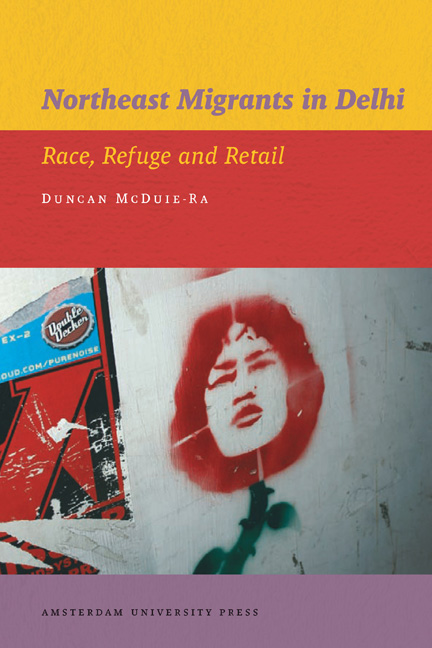Book contents
- Frontmatter
- Contents
- List of Maps and Images
- Acknowledgements
- Maps
- 1 Introduction
- 2 Leaving the Northeast
- 3 Coming to Delhi
- 4 Backward, Head-hunter, Sexy, Chinky
- 5 Provincial Men, Worldly Women
- 6 Place-making in the City
- 7 Conclusion
- Short Biographical Note on the Author
- Bibliography
- Index
- Publications Series
4 - Backward, Head-hunter, Sexy, Chinky
Published online by Cambridge University Press: 14 January 2021
- Frontmatter
- Contents
- List of Maps and Images
- Acknowledgements
- Maps
- 1 Introduction
- 2 Leaving the Northeast
- 3 Coming to Delhi
- 4 Backward, Head-hunter, Sexy, Chinky
- 5 Provincial Men, Worldly Women
- 6 Place-making in the City
- 7 Conclusion
- Short Biographical Note on the Author
- Bibliography
- Index
- Publications Series
Summary
Racism defines the Northeast migrant experience of Delhi. For those unfamiliar with the Northeast region, this may seem a moot point. India is made up of diverse peoples from different ethnic lineages, so what makes migrants from the Northeast unique? Different groups in India experience prejudice and discrimination when they migrate and, for more marginal groups, even in their home locations, so why are migrants from the Northeast any different? The answer is race. Northeast migrants are seen as racially different from the Indian mainstream. India contains many communities earmarked as ‘others’ based on religion, caste, and even ethnicity, yet the nationality and origin of these communities are not questioned at every turn. They can ‘blend in’ to the heartland in ways that Northeast migrants cannot. This is not to argue that these ‘others’ do not face discrimination and violence; rather, the experiences of Northeast migrants are distinct and reveal different elements of contemporary Indian society as the distance between frontier and heartlands shrink.
For Northeast migrants, physical appearance is central in interactions with members of other communities and with other Northeasterners. Physical features denoting Tai, Tibeto-Burman, and Mon-Khmer lineages mark Northeasterners as separate from the Indian mainstream, even when accounting for the diversity of that mainstream. In fact, these features routinely lead to questioning of nationality and citizenship. Race is not isolated from the social fields in which individuals and groups exist (Wimmer 2008). Through their physical appearance, Northeast migrants are not simply viewed as others, but their otherness is also associated with the ways the Northeast frontier is understood and misunderstood socially and politically in the Indian mainstream. Importantly, many Northeasterners do not contest their difference from the Indian mainstream. Yet firm ethnic and even separatist identities do not supplant the realities of racism experienced by migrants throughout their time in Delhi and other heartland cities. In the course of a single journey across Delhi in a bus, a Northeast migrant may be judged as immoral and sexually promiscuous, a backward subject from the misty jungle, an anti-national rebel, a Chinese national, and a privileged elite benefitting from government reservations.
- Type
- Chapter
- Information
- Northeast Migrants in DelhiRace, Refuge and Retail, pp. 87 - 118Publisher: Amsterdam University PressPrint publication year: 2013



